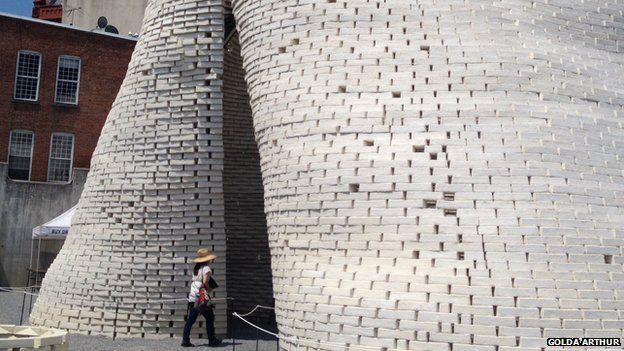A tower, assembled from 10,000 bricks, has been made from mushrooms. “This is a hybrid of what I call an ancient technology of mushrooms and a totally new technology of computation and engineering,” says architect David Benjamin. The 40ft (12m) structure he is referring to currently sits in a courtyard at MoMA PS1, an art gallery in New York.
 Mycelium, the vegetative part of the fungus, is an ideal material, Mr Benjamin explains. These bricks score high marks for sustainability because they were “grown” with no carbon emissions and no waste. The mushroom brick is “grown” by mixing together chopped-up corn husks with mycelium. The mixture is then put into a brick mold and left to grow for five days. The result is a brick that is solid, but lightweight.
Mycelium, the vegetative part of the fungus, is an ideal material, Mr Benjamin explains. These bricks score high marks for sustainability because they were “grown” with no carbon emissions and no waste. The mushroom brick is “grown” by mixing together chopped-up corn husks with mycelium. The mixture is then put into a brick mold and left to grow for five days. The result is a brick that is solid, but lightweight.
 This method lets builders use local materials like agricultural waste, and also makes the bricks biodegradable. These particular bricks were created from materials in the New York area, but in places where rice is abundant, people can use rice hulls in the mixture with mycelium to create bricks.
This method lets builders use local materials like agricultural waste, and also makes the bricks biodegradable. These particular bricks were created from materials in the New York area, but in places where rice is abundant, people can use rice hulls in the mixture with mycelium to create bricks.
 “We want to use living systems as factories to grow new materials,” he says. “Hopefully this will help us see cities more as living breathing organisms than solid, static, inert places.”
“We want to use living systems as factories to grow new materials,” he says. “Hopefully this will help us see cities more as living breathing organisms than solid, static, inert places.”
Meanwhile another architect has also been growing “bio-bricks”, using a different process. Ginger Krieg Dosier is the creator of a brick made with sand and bacteria, filled into a mold and then fed with a nutrient solution. Five days later, the bricks are removed and ready to use. The chemical reaction caused by this mixture “bio-cements” the grains together to create a solid brick. These brick are now being used in a pilot project to make paving.
“While they are experimental, it is very exciting to see these types of leapfrog technologies that take cues from nature to find creative alternatives to some of the oldest conventions in design,” says Jacob Kriss from the US Green Building Council. “There is an unquestionable imperative to green our stock of both new and existing buildings,” Mr Kriss says. “It is these types of innovations that can help us turn the corner to create resilient, healthy, high-performing structures that are better for the planet and the people who use them every day.”
You can read the original article at www.bbc.com

Clearly you can build four floors with this new material.